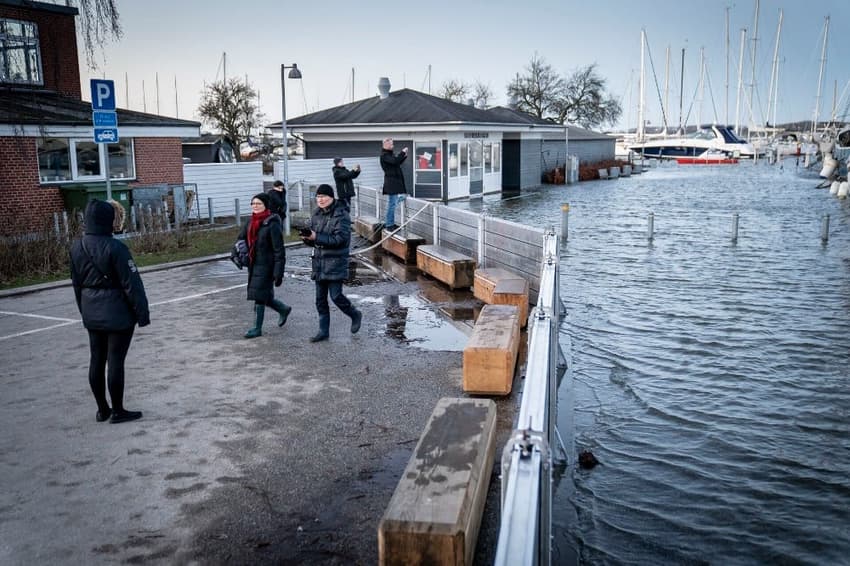What can homeowners in Denmark do to protect houses from high water damage?

With windy conditions expected to cause raised water levels in some coastal parts of Denmark this weekend, homeowners have been advised that their insurance policies may not protect them against potential damage.
An organisation which provides insurance advice has warned coverage is unlikely to protect homeowners against damaged sustained from high waters, and recommended steps to minimise potential water damage to properties.
“Normally, high water levels are not covered by regular home insurance, home contents insurance or summer house insurance. So it’s a very good idea to prepare if there are high water alerts,” Anne Garde Slothuus of insurance guidance organisation Forsikringsoplysningen told news wire Ritzau.
Denmark's met office DMI on Wednesday issued a level three warning for "dangerous" storm surges south of Copenhagen and around the Little Belt strait, with sea levels as much as 2m higher than normal in some places.
According to the forecaster, sea levels will be between 1.7m and 2m higher than normal between Friday afternoon and Saturday morning in the worst affected area, which stretches from the South Funen Archipelago up into the Little Belt strait between Funen and Jutland.
The southern suburbs of Copenhagen, such as Avedore, Ishøj, and Brøndby, the south-east Zealand coast, and the coast of Lolland-Falster, will be hit by a less severe storm surge, taking sea levels to between 1.4m and 1.8m higher than normal.
READ ALSO: Danish forecaster warns of 'dangerous' two-metre storm surge
Fire services in Funen’s Assens Municipality have delivered sandbags to residents in the area to help them shore up their homes against the high waters.
Blocking doors, windows and other openings to homes is one of a number of steps that can be taken to prevent or minimise damage, Slothuus said.
“Make sure all drains, gutters and so on have been cleared so there’s free passage,” she advised.
“If you have things stored in a basement, make sure they are raised and not standing directly on the floor,” she said.
Being unable to secure your home against water damage is not normally considered a mitigating circumstance when making insurance claims, even if you were away from home at the time or physically unable to put the protections in place, she explained.
Homeowners should nevertheless always check with their insurance providers as to the extent of their coverage.
“Normally, the three insurances [home, contents and summer house, ed.] do not cover damage caused by flooding from storms or the sea, lakes or drainage systems,” Slothuus said.
The Danish National Hazards Council has the remit of determining whether a weather event can be considered storm-related flooding, also known as storm surge. Homeowners can contact the council to ask whether damage to their houses can be covered by the council’s fund for storm floods.
Extremely high water levels are rare and statistically only occur once every 20 years, according to Slothuus.
Comments
See Also
An organisation which provides insurance advice has warned coverage is unlikely to protect homeowners against damaged sustained from high waters, and recommended steps to minimise potential water damage to properties.
“Normally, high water levels are not covered by regular home insurance, home contents insurance or summer house insurance. So it’s a very good idea to prepare if there are high water alerts,” Anne Garde Slothuus of insurance guidance organisation Forsikringsoplysningen told news wire Ritzau.
Denmark's met office DMI on Wednesday issued a level three warning for "dangerous" storm surges south of Copenhagen and around the Little Belt strait, with sea levels as much as 2m higher than normal in some places.
According to the forecaster, sea levels will be between 1.7m and 2m higher than normal between Friday afternoon and Saturday morning in the worst affected area, which stretches from the South Funen Archipelago up into the Little Belt strait between Funen and Jutland.
The southern suburbs of Copenhagen, such as Avedore, Ishøj, and Brøndby, the south-east Zealand coast, and the coast of Lolland-Falster, will be hit by a less severe storm surge, taking sea levels to between 1.4m and 1.8m higher than normal.
READ ALSO: Danish forecaster warns of 'dangerous' two-metre storm surge
Fire services in Funen’s Assens Municipality have delivered sandbags to residents in the area to help them shore up their homes against the high waters.
Blocking doors, windows and other openings to homes is one of a number of steps that can be taken to prevent or minimise damage, Slothuus said.
“Make sure all drains, gutters and so on have been cleared so there’s free passage,” she advised.
“If you have things stored in a basement, make sure they are raised and not standing directly on the floor,” she said.
Being unable to secure your home against water damage is not normally considered a mitigating circumstance when making insurance claims, even if you were away from home at the time or physically unable to put the protections in place, she explained.
Homeowners should nevertheless always check with their insurance providers as to the extent of their coverage.
“Normally, the three insurances [home, contents and summer house, ed.] do not cover damage caused by flooding from storms or the sea, lakes or drainage systems,” Slothuus said.
The Danish National Hazards Council has the remit of determining whether a weather event can be considered storm-related flooding, also known as storm surge. Homeowners can contact the council to ask whether damage to their houses can be covered by the council’s fund for storm floods.
Extremely high water levels are rare and statistically only occur once every 20 years, according to Slothuus.
Join the conversation in our comments section below. Share your own views and experience and if you have a question or suggestion for our journalists then email us at [email protected].
Please keep comments civil, constructive and on topic – and make sure to read our terms of use before getting involved.
Please log in here to leave a comment.